
words Johanna Agerman and William Wiles
Nelly Ben Hayoun
MA Design Interactions
The Soyuz chair
This monstrosity of a chair lets you experience the first 10 minutes of a space flight in the comfort of your living room. “It’s not a joke at all,” says Ben Hayoun. “It’s about making an engaged project and accessing people’s dreams.” The Soyuz chair is a specially engineered chair, which Ben Hayoun built with the help of technician Tom Hulbert and with a soundtrack by Tim Holden. It is covered in a PVC textile that makes the experience more realistic by making the user sweat. As a domestic object it challenges our perception of the function of a chair – maybe we should expect more from the things in our homes? The Soyuz chair will be part of Dunne & Raby’s What if? exhibition at Dublin’s Science Museum in September.

Dominic Hargreaves
MA Design Products, Royal College of Art
Fold Up Bike
The Brompton bike has finally got a rival in Hargreaves’ new folding bicycle. Unfolded, its lightweight, aluminium frame is shaped like an ellipse. “I was fed up with folding bicycles folding up on me while cycling,” says Hargreaves. This model is completely rigid when unfolded and by simply unhooking the joints, the frame folds away to the size of one of its wheels. It is then locked into place with the other wheel, making it possible to wheel it behind you when not in use.
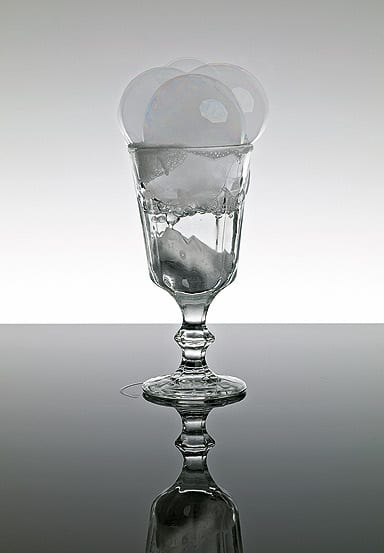
Zoe Papadopoulou and Cat Kramer
MA Design Interactions, Royal College of Art
The Cloud Project
Kramer and Papadopoulou distributed ice cream-scented clouds and smoke-filled ice cream cones from their retro ice cream van parked outside the RCA Show. But it wasn’t just an arty take on canapés. Instead it attempts to educate passers-by on the latest scientific developments. The van is a way of disseminating information about developments in areas such as nanotechnology, which are important but often difficult to understand. Kramer and Papadopoulou propose that it could park outside institutions, drawing in people for a casual chat on scientific topics.

Valentin Vodev
MA Design Products, Royal College of Art
Radio Valerie
The adorable Radio Valerie looks like it’s asking for you to touch it. It has all its switches integrated into the design, with nothing but the antenna protruding from it. The radio is switched on and the volume controlled by rotating the speaker found on the top. To tune into a radio station you just pull the antenna to the left or right.
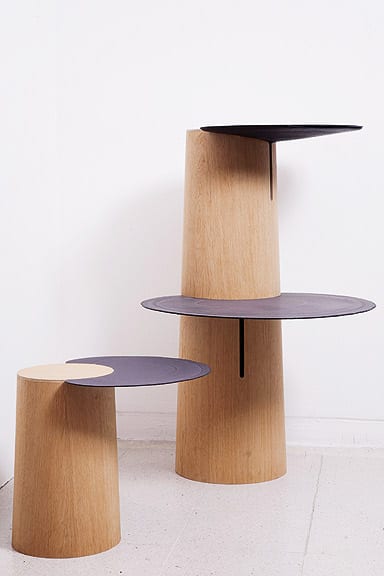
Claire Ferreira
MA Design Products, Royal College of Art
Downside Up Table
Ferreira is interested in the upside-down world, as all of her graduate projects showed. The most interesting was the Downside Up table. It is produced by pouring Jesmonite bio-resin into an oak veneered laminated plywood base and letting it leak out through slits on the side. When it is turned over, the hardened Jesmonite functions as a table top or shelf with a unique shape.
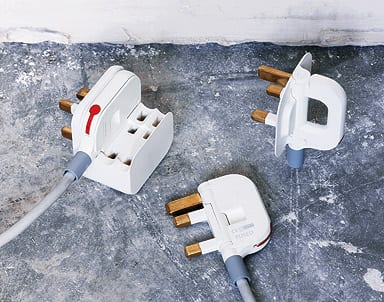
Min-Kyu Choi
MA Design Products, Royal College of Art
UK Folding Plug
“I didn’t quite imagine this response,” says Choi. His three-pin folding plug caused quite a sensation at the RCA Show 2 with its simple but ingenious idea – the bulky British plug made slim. “It started with my personal experience of buying a shiny new MacBook,” says Choi. “I put it in my bag with the three-pin plug and the plug scratched the surface of the MacBook and that made me very upset.” Choi’s plug is just a visual prototype, but manufacturers are very interested and the designer hopes to secure funding to take it through the next stage – passing British health and safety standards.
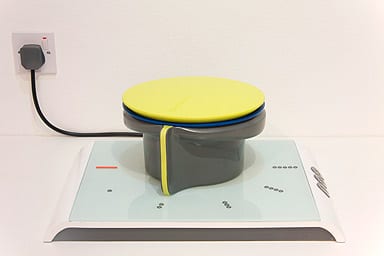
Menno Kroezen
MA Industrial Design and Engineering, Royal College of Art
Touch&Turn
Kroezer developed a pot and cooking plate for partially sighted people that makes the process of cooking food a lot easier by designing out the risks involved. The Touch&Turn pot and cooking plate comprises an insulated pot that is cool to the touch and that slots onto the cooking plate without the user having to touch any hot parts. The pot then simultaneously function as a switch to control the temperature of the hotplate and for extra assistance it comes with audio feedback.
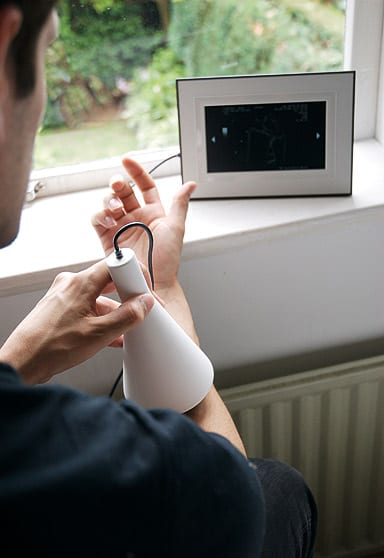
Mike Thompson
MA IM, Design Academy Eindhoven
Growing Pains
In order to nurture the relationship between man and object, Thompson has taken the design and production process to extremes, proposing that objects could be grown inside humans. His ideas included growing a wind instrument out of your clavicle bone and making chess pieces of your metacarpal bones. It’s like something out of a Cronenberg flick.

Sonja Bäumel
MA IM, Design Academy Eindhoven
Invisible Membrane
This project explores the bacteria that covers our skin. Merging fashion with science, Bäumel decided to create a visual reminder of the grime that we are all covered in. One of the end products is this crocheted glove which displays bacteria build-up as a unique pattern, although it’s not wholly clear how. It’s a visualisation of the idea that unique bacteria populations could be used to create garments that react to the individual’s body temperature.

Gregory Brunisholz
BA Industrial Design, ECAL
Tabourets
These stools have a thin quilted cushion wrapped over a wooden core and held in place with a fabric strip. They are inspired by sushi, but possibly also share some DNA with Hella Jongerius’ 2007 Backpack stool for Galerie Kreo and Jasper Morrison’s crates for Established & Sons.
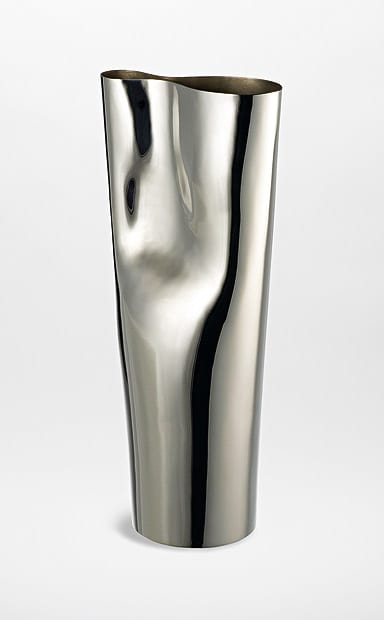
Henrique da Silva Fernandes
Mas Luxe, ECAL
Jug for Christofle
This water jug has a pinched top that stops the ice cubes dropping out when a drink is poured. Cubes go in the wider aperture on the right, water is poured from the left. Made for silversmith Christofle, one of the high-end brands partnering with ECAL on the luxury course, it’s a simple and elegant bit of problem-solving that has yielded a beautiful, sculptural form.
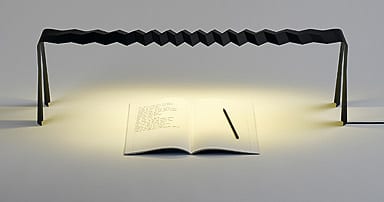
Delphine Frey
Mas Luxe, ECAL
Lampe
Carbon fibre, the luxury material designers can’t seem to get enough of at the moment, cropped up in a few Mas Luxe pieces, including two by Delphine Frey. This slender, kinked desk lamp was made with the assistance of Formula One engineers. The carbon fibre is also functional, conducting electricity through the light. Rising star Frey also designed a memorable porcelain ice-cream cone for Bernardaud in 2007.

Julien Renault
BA industrial design, ECAL
En Aluminium stools
These stools were easily the most interesting project from ECAL’s industrial design course. They are made of anodised aluminium, not an uncommon material, but here it has been hand-forged with hammer and tongs over a fire. This gives them a peculiar surface quality similar to old iron or pewter pieces.
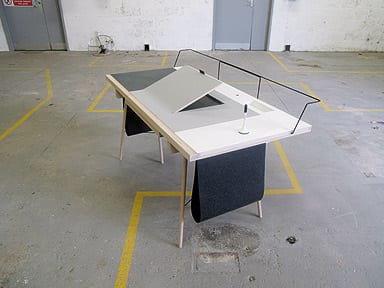
Robin Grasby
BA 3D Design, Northumbria University, seen at New Designers
Homework
Grasby won both the Habitat and 100% Design awards at New Designers for his Homework desk. Its separate elements can be mixed and matched to create the perfect workstation. Everything from the desktop size to the position of the trestle legs can be adjusted to individual needs. The felt slings provide storage for documents and magazines.
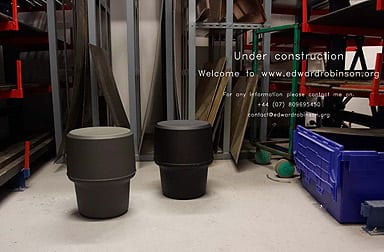
Edward Robinson
BA 3D Design, Northumbria University, seen at New Designers
Spun stool
This collapsible drinking bottle fits into a Oyster card wallet. It scores highly in two respects: it banishes bulky water bottles and satisfies our thirst for green products. The commuter fills their Tap Up from a water fountain, hydrates themselves during their journey, then tucks it neatly back into its sleeve. The vacant slot in the Oyster card wallet has always needed something to fill it, anyway.
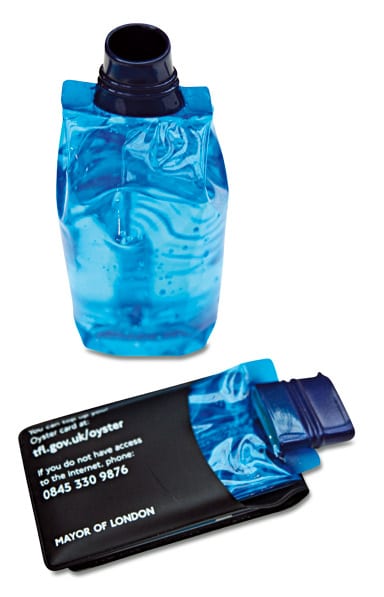
Amy Smith
BA Product Design, Ravensbourne College of Design and Communication, seen at New Designers
Tap Up
This collapsible drinking bottle fits into a Oyster card wallet. It scores highly in two respects: it banishes bulky water bottles and satisfies our thirst for green products. The commuter fills their Tap Up from a water fountain, hydrates themselves during their journey, then tucks it neatly back into its sleeve. The vacant slot in the Oyster card wallet has always needed something to fill it, anyway.
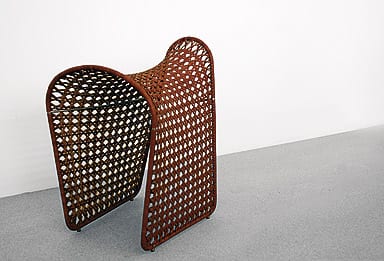
Matthew Woodhouse
Bucks New University, seen at New Designers
Linear Construction Stool
This saddle-like stool is constructed by weaving strips of leather around a metal frame, using an old technique called double Victorian cross weaving. It was traditionally used for seatbacks, but in this piece Woodhouse used it for the entire stool. “I had to learn it from scratch,” says Woodhouse, who started out with simpler 2d shapes. The ends are different shapes, giving it a beautifully sculptural form and the weave provides natural suspension that makes it a really comfortable seat.
















